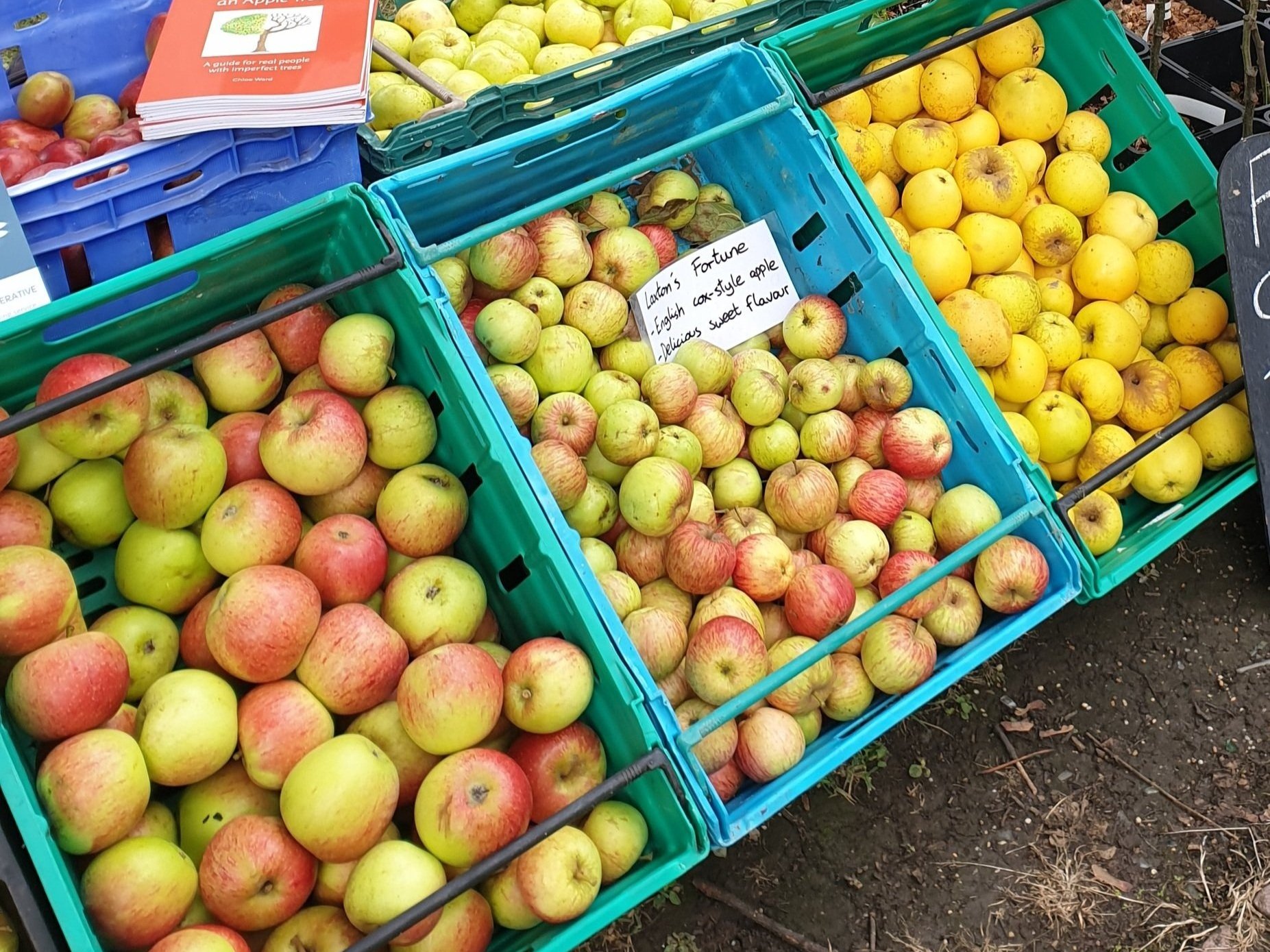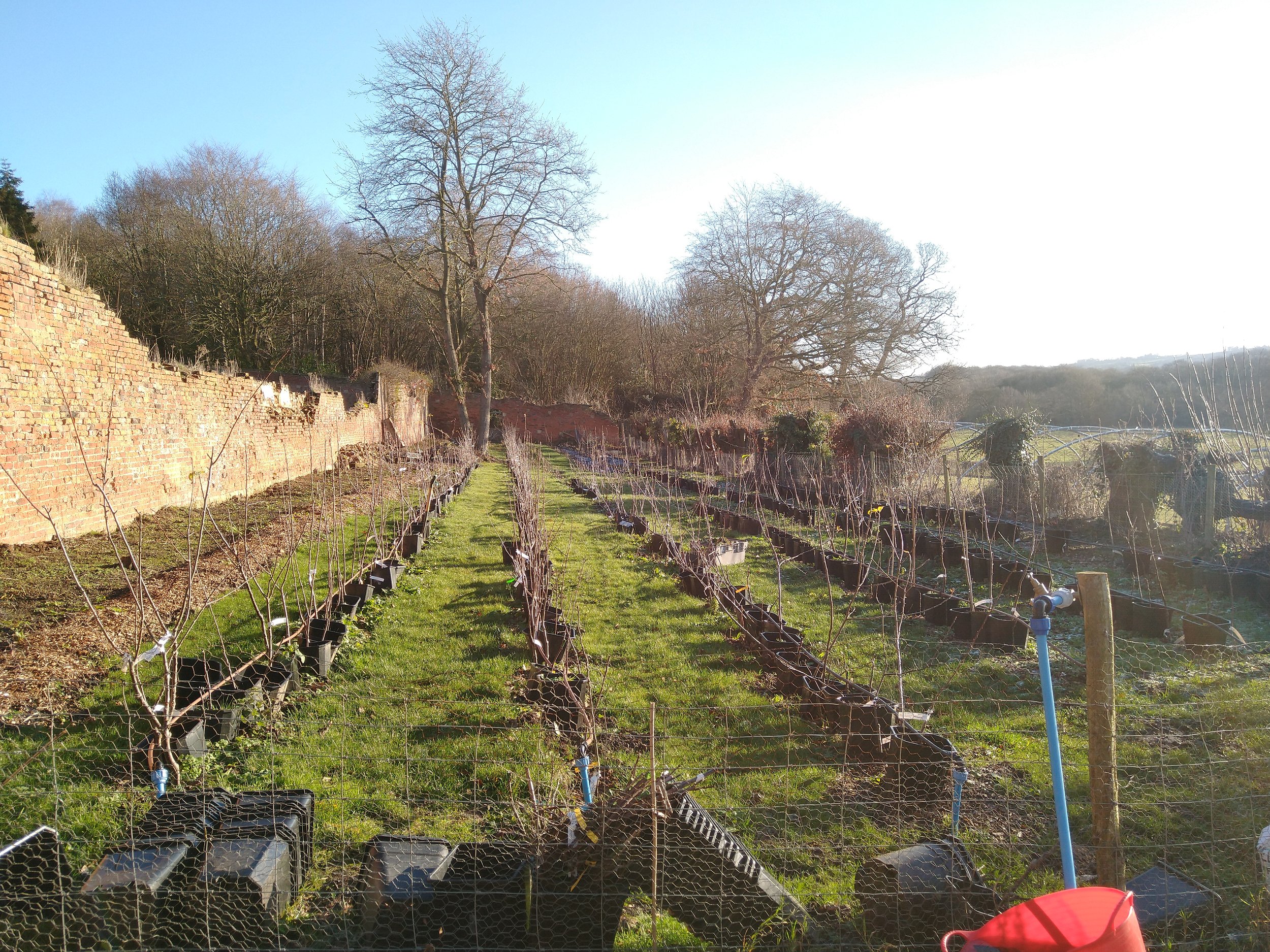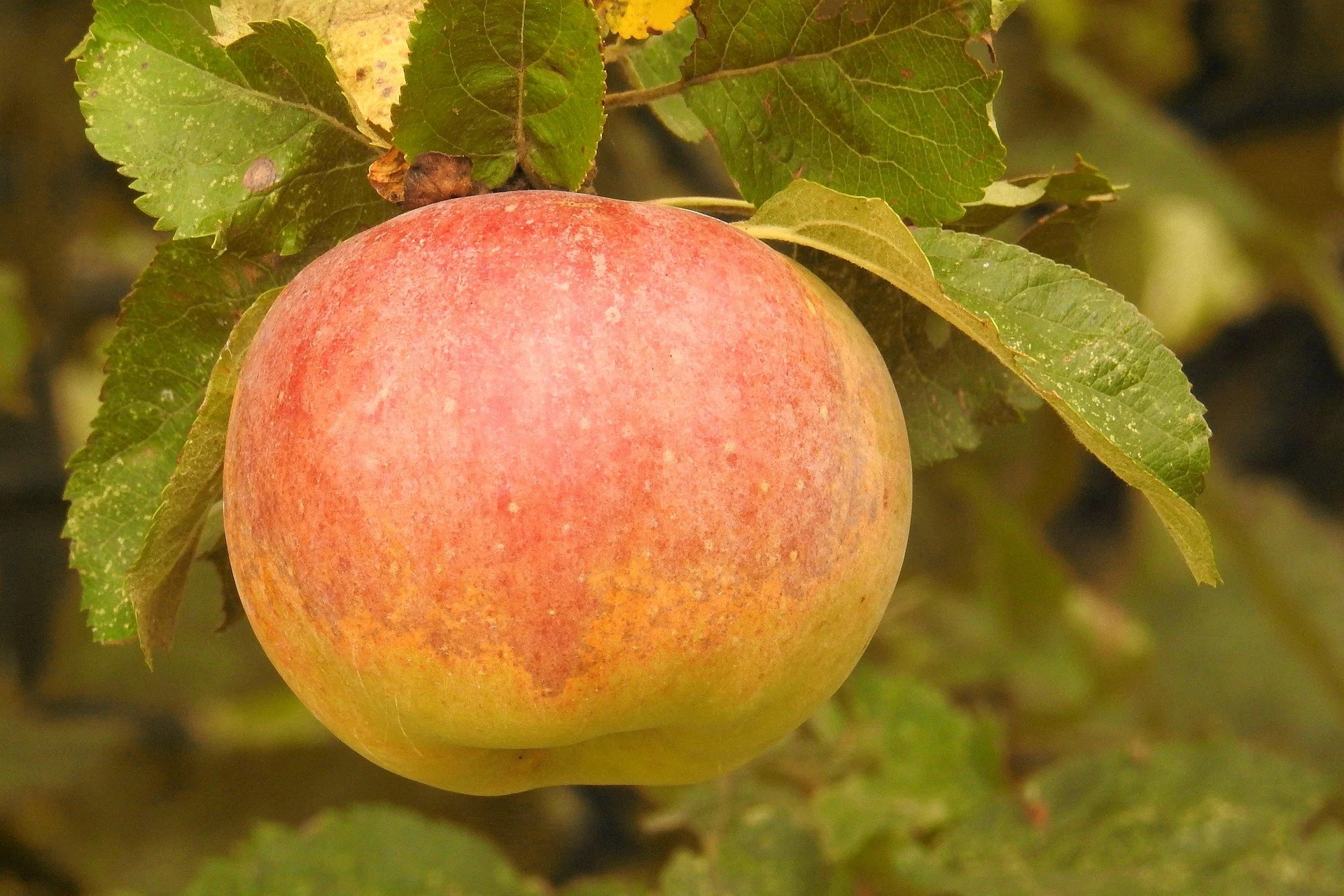Which Fruit Tree(s) Should You Buy? All the Factors You Need to Consider
Choosing the right fruit trees for your garden or community space can feel like a daunting task—especially when you see the endless options, confusing terminology, and conflicting advice. But don’t worry! We’ve broken it all down into simple steps, so you can pick the perfect tree for your space and needs.
What You’ll Need to Decide
When you buy a tree, you’ll usually need to select:
The variety – e.g. Gala, Bramley. You should consider:
Pollination needs
Season of use
Whether eater/cooker/cider variety
What you like!
The rootstock that the tree is grown on. This determines the plant’s vigour and ultimate size. – e.g. MM106 (semi-vigorous), M9 (dwarfing). You should consider:
How large you want the tree to grow
Whether and how much you’re going to prune or train it
The growing conditions
How big a crop you want, and how soon
The form or age – e.g. maiden, bush, standard, espalier, 1 yr old, 2 yr old. You should consider:
Where you’re going to grow the tree(s) and whether you want to train them
How many varieties you want to grow
Whether potted or bare root. You should consider:
When you want your tree(s) — bare root trees can only be supplied during dormant season
Price — bare root trees are cheaper and can normally be shipped more easily
When you’re ready to plant — bare root trees need to be planted before they come back out of dormancy. Potted trees can be bought and planted year round, but need greater care and attention (watering).
In this article, we’ll go through the top things to think about when choosing fruit trees, so you can make your selection with confidence.
The Top 7 Things To Consider When Choosing Fruit Trees
Space — Where Will My Trees Go?
Observe your site and ask yourself the following questions:
Where is there space for a tree/trees? Think ahead to the ultimate size of the tree, and use the rootstocks guide image below to decide which rootstock would be most appropriate.
Does the spot you have in mind get enough sun? Generally speaking, fruit trees in the UK want at least 6-8 hours of sun per day during the growing season (spring and summer).
Is there a good spot for trained fruit? Sunny, vertical spaces like walls and fences are ideal for trained fruit. Or you can install a new set of wires.
What is the soil like? Your trees will do best in well-draining loam soil, but various soil types can work well with the addition of organic matter such as a mulch of woodchip.
Rootstocks explained: how tall your tree will grow to be
The rootstock is the part of the tree that controls how large the tree will grow. Want to know more about rootstocks? Check out our guide here.
-
It’s often possible to grow fruit trees even in a small space, by using containers or by training your fruit trees.
-
To grow a fruit tree in a pot, select a large container with drainage (around 90cm width and depth), fill it with compost and plant your tree.
Usually it’s advised to plant dwarfing trees in containers as their smaller root systems will be happier. However, trees on more vigorous rootstocks do work too, because the container will naturally restrict the growth of the tree. There are different approaches and theories, so have fun experimenting!
Just remember, trees in containers will need watering more frequently than those planted in the ground. It’s a good idea to mulch the soil with woodchip, which helps the soil beneath to retain moisture.
-
Training fruit trees is a great way to grow fruit in a small space, and to grow more than one variety. The next section will tell you more.
2. Form — Which Rootstock for Which Shape?
There are various different ways of growing fruit trees, the most common being a ‘bush’ form, which we would associate with the natural shape of a tree. A ‘standard’ is similar but branches out higher up, resulting in a taller trunk.
You can also consider training fruit trees as espaliers, cordons, fans or stepovers.
Image Credit: Quercusrobur at English Wikipedia
Ask yourself:
How many trees do I want?
How many can I realistically fit in the space available, based on how large they will eventually be and how I plan to train them (if at all)?
How much am I prepared to train and prune?
What’s the likely future of this garden or patch of land?
Dwarf Tree(s) in a Natural ‘Bush’ Shape — Which Rootstock to Select
To control the height of your tree with certainty, choose one which has been grown on a dwarfing rootstock, such as M27, M9 or M26 (for apples). These will grow to be beautiful miniature trees and tend to start fruiting earlier in their life.
What are the downsides of dwarfing trees? They will ultimately produce a smaller crop than trees on more vigorous rootstocks. And because of their weaker roots, they’re also more susceptible to being blown over and may require staking through their full lifespan.
You can still grow small trees on more vigorous rootstocks like MM106 if you prune them hard and routinely. So if you’re confident in pruning, you could opt for trees on more vigorous rootstocks even if you want to keep them quite small.
Want to become confident at pruning? Going on a course is a great way to do this.
Trained Fruit Ttree(s) – What To Buy
There’s a lot to think about if you want to train your trees in forms like cordons, espaliers or stepovers.
You can buy fruit trees that are pre-trained, but remember that you’ll still need to keep on top of pruning and training them as they continue growing.
Alternatively, to train the tree yourself from scratch, make sure you buy a ‘maiden’ tree, which may also be listed as a 1-year-old or small tree (check with the nursery if you’re unsure). These trees will have a single stem, which you will prune back in the winter to start the training process.
Which rootstock is best for trained fruit? Most rootstocks are suitable. If your site is exposed, choose a more vigorous rootstock like MM106 to protect the trees from being blown over.
3. Your Fruit Preferences — What You Like and How You Like to Consume It
It may sound obvious, but it’s worth thinking about what kind of fruit you like to eat. You might end up with a lot of this fruit on your hands one day when your trees are mature. It helps if you really like it!
Plus, growing a fruit that you love means you’ll be excited to tend to your tree and set it up for a healthy, happy life.
Ask yourself:
What varieties have I really enjoyed?
How do I want to use the fruit? Do I want to cook it, eat it, juice it or brew cider with it? Do I want a versatile dual-purpose variety?
Do I actually care which variety I grow? If not, that’s totally valid! You can hardly be expected to have tried the thousands of different fruit varieties available. Most nurseries will be happy to select something reliable and delicious for you, based on the kind of thing you like.
If you’re unsure, get in contact with us or another nursery for advice on what to choose.
4. Season of Use: When Do You Want The Fruit?
Different fruit varieties will ripen at different times in the season. This information is usually written on the product page on an online nursery shop.
Does It Keep?
One reason that apples are more popular to grow than plums, cherries or pears is the fact that many of them keep remarkably well.
As a general rule, apples that ripen late in the season will keep for longer than early season ones, but it does vary between varieties. So read up on your chosen varieties if you want a long keeping apple. The flavour of fruits will mature and change during storage.
With a late keeping apple, you can keep your abundant harvest in storage (e.g. in a well ventilated shed), and have a supply of apples throughout the winter, sometimes as late as March.
Is It For Eating, Cooking, Juicing or Cider?
Considering when you want fruit links back to the previous point: how do you want to use the fruit?
Let’s imagine you want to grow just one large apple tree in your garden.
A sweet, early-season eating apple would be a tempting choice if you like that kind of fruit. But consider whether you’d be able to use it all when you have a large tree producing several kilos of fruit ripening all at once. A good way around that conundrum is to use the fruit to make juice, or take it along to a community Apple Day. If you think you’ll do that, then an early season sweet eater is a great choice.
If on the other hand, you’re not interested in juice and you prefer to eat or cook it, then it could be better to go for a variety that will keep for longer and is dual-purpose.
Growing Multiple Trees? Spread Out the Seasons
If growing more than one tree, it’s a great idea to grow varieties that will ripen at different times. So you’ll have early ones to enjoy, followed by your mid-season and then late-season fruits.
5. Chance of Success
Most of us who grow fruit trees are doing so because we want fruit, so we should give some thought to the likelihood of successfully harvesting fruit from our trees. We want the trees to survive and thrive, and we want them to fruit!
Apples, pears, plums and cherries will all grow reliably in the British climate, although cherries will very often be eaten by birds.
Apples are the hardiest of all, so for the highest likelihood of survival and a regular crop – and lowest chance of heartbreak! – they are an excellent choice.
Strength in Diversity
Not only is variety the spice of life, it’s also the path to resilience in any growing space.
If you have the space for multiple trees, then growing a wide range of varieties is recommended. This will give you a higher chance of harvesting something year on year.
Various factors can cause a tree to not bear fruit, and with multiple varieties growing, if one of your crops fails, you have several others to fall back on.
Plus, multiple trees increases the chance of pollination.
Pollination
For a successful crop, most fruit trees need pollination from a tree of the same species (e.g. apple, pear) that’s in flower at the same time.
How to know whether varieties will pollinate each other:
Varieties are classed into ‘pollination groups’ on nursery websites or catalogues. Varieties in neighbouring groups (or the same group) can pollinate each other (unless they’re triploid varieties, which cannot pollinate other trees).
An example of choosing trees with pollination in mind:
Let’s say you want to plant a pear tree. You should look around your local area and see whether there are other pear trees around that can act as a pollination partner.
If there aren’t, you should either:
Choose a self-fertile variety. For example: Conference pear. Self-fertile varieties don’t require a pollination partner to produce a crop so they’re a safe choice if you’re unsure. However, they do still benefit from pollination and will produce a better yield if near to a pollination partner.
Plant two or more pear trees that can be pollination partners for each other. Let’s say you like the variety Doyenne du Comice. It’s listed as self-sterile, which means it can’t pollinate itself. It’s in pollination group C, so you need to look for another pear tree which is in group B, C or D.
What about urban spaces like cities?
In a city, you don’t need to be too concerned about pollination because there’s such a high density of fruit trees in gardens and allotments: pollination is more or less guaranteed.
How far apart can pollination occur?
Bees can travel considerable distances, however to be on the safe side it’s best to ensure trees that can cross-pollinate each other are planted within 100m or so of each other. The closer the better.
Want to know more about pollination? See our explainer page here.
6. Where to Buy: Nursery Growing Practices and Ethics
The Fruit Works Nursery in Leeds
Finally, think about where you want to source your trees from.
You’re growing fruit trees, which is a fantastic thing to do no matter where the trees began their lives, but it’s much better still if the early life of your trees was regenerative for the Earth rather than harmful.
While there’s an important place for large-scale nurseries, many of them use artificial fertilisers, pesticides and fungicides - derived from fossil fuels - as routine in their growing practice. The harms caused to wildlife, biodiversity and human health are well documented.
Try to buy from local and/or small-scale nurseries (such as ours), who are likely to be using organic growing methods even if they don’t have certification. Or choose a certified organic nursery.
Read what the nursery has to say about their growing practices on their website, or ask them.
Still not sure what to choose?
Feel free to email us about the space you have and the kind of fruit you like, and we’ll happily select something for you.
Or, go for one of the varieties listed below, which we’ve picked because of their reliability and great taste!
Easy Varieties to Grow
Go For It and Get Planting!
With the right tree in the right place, a little pruning and a little patience, you’ll be enjoying the bounty of your chosen trees in no time!
So whether you’re growing a small potted tree or a community orchard, keep these basic principles in mind and make your choices with confidence. Enjoy!












A small to medium dessert apple. Fruit is yellow, red skinned with slightly tart flavour.
Type: Dessert
Season: Sep-Oct
Pollination: Self-sterile. Pollination group D